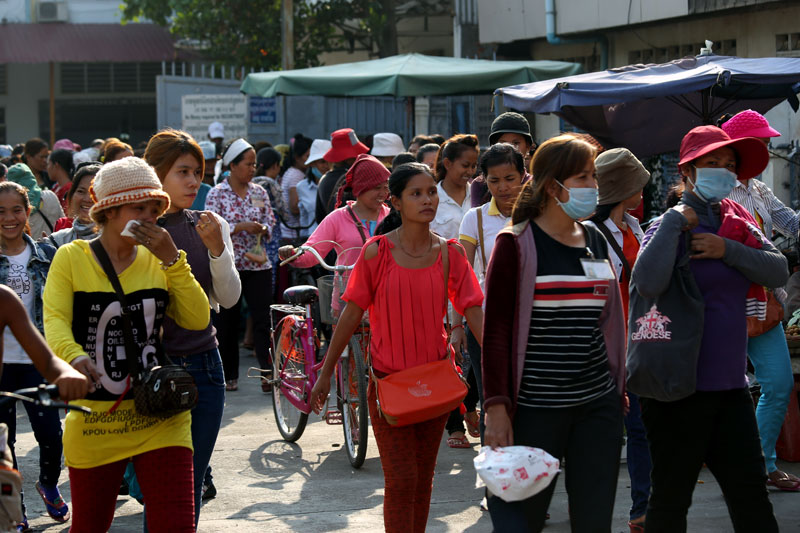The vast majority of the country’s 600,000-strong garment factory workforce appeared to be back on the job Monday despite a call from unions to continue a stay-at-home strike until Tuesday.
Eight unions had spent weeks urging workers to stay home after the Khmer New Year from April 17 to 22 in hopes of pressuring the government and factories to raise the sector’s monthly minimum wage from $100 to $160. They also want the courts to release 21 unionists and workers arrested during the last round of wage strikes that ended in January.

By Monday morning, however, all factories were back up and running and most of their workers were back at their stations.
Outside her factory on Phnom Penh’s Veng Sreng Street, Khorn Ya said about 80 percent of her 500 or so coworkers were back Monday, not wanting to miss out on a day’s pay.
“If the workers don’t go back to work, we will have our salaries cut, so we have to go to work,” she said.
Chhum Vet, who works at another garment factory along Veng Sreng, said between 80 percent and 90 percent of her coworkers were back Monday.
She and many of her coworkers felt pressured to return after seeing others heading back.
“I heard about the strike until April 23, but most workers went back to work today so I went back to work, too,” she said. “If most workers had gone on strike, I would have joined the strike, too.”
Ek Pheakdey, secretary-general of the Coalition of Cambodian Apparel Workers Democratic Union, claimed that only about 30 percent of his union’s 100,000 members were back at work Monday and that only about 60 percent of all garment workers had returned.
Three of the other unions behind the strike, however, said that up to 90 percent of the workforce was back Monday.
“We are not satisfied because the workers did not strike until April 23, as our unions said,” said Far Saly, president of the National Trade Union Coalition.
Sieng Sambath, president of the Workers Friendship Union Federation, blamed the failed strike on authorities for making it hard for the unions to publicize the strike.
Ahead of Khmer New Year, some union members were temporarily detained for distributing leaflets promoting the strike and had their pamphlets confiscated. Authorities also made repeated threats to arrest anyone handing out the leaflets.
“The workers went back to work today because they did not get enough information from us …because the authorities pressured us,” Mr. Sambath said.
However, Yaing Sophorn, president of the Cambodian Alliance of Trade Unions, said their efforts were at least a minor success, having convinced some factories to extend the new year holidays by one or two days.
GMAC Secretary-General Ken Loo also said that up to 90 percent of garment workers were back on the job Monday. But he said it was normal for a few workers to come back to work a day or two late after the new year holiday, which usually involves a trip to the provinces to visit relatives, and had nothing to do with the attempted strike.
He also rejected the suggestion by some unions that the extended holiday some factories gave their workers would hurt them financially by delaying their production schedules.
“Factories always manage their holidays and I’m sure the factories always planned to give their workers an extended holiday, so this was within their plans,” he said.
Still hoping to win their wage hike, the unions behind the stay-at-home strike plan to hold a rally at Phnom Penh’s Freedom Park on May 1—international labor day—and will submit their request to the municipal government in the coming days.
(Additional reporting by Zsombor Peter)




